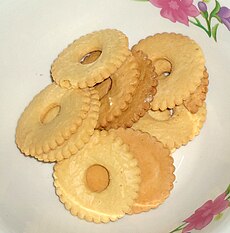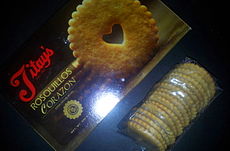Rosquillo
Appearance
  | |
| Course | Pastries |
|---|---|
| Place of origin | Philippines |
| Region or state | Cebu |
| Main ingredients | Flour, eggs, shortening, sugar, and baking powder |
Rosquillos are Philippine cookies made from flour, eggs, shortening, sugar, and baking powder. They were originally created by Margarita “Titay” T. Frasco in 1907 in Liloan, Cebu.[1][2][3] The name means "ringlet" in Spanish (from rosca, "ring") and was reputedly coined by Philippine President Sergio Osmeña.[4][5]
Despite sharing the name, Philippine rosquillos are not related to the Spanish rosquillos (better known as rosquillas, roscos, or rosquillos de vino), which are more akin to baked doughnuts.[6][7]
See also
References
- ^ Angelo Comsti (2014). The Filipino Family Cookbook: Recipes and stories from our home kitchen. Marshall Cavendish International Asia Pte Ltd. p. 132–133. ISBN 9789814634946.
- ^ "Rosquillos". Cebu Tourism. Retrieved December 26, 2014.
- ^ Pia Lim-Castillo (2007). "Eggs in Philippine Church Architecture and its Cuisine". In Richard Hosking (ed.). Eggs in Cookery: Proceedings of the Oxford Symposium of Food and Cookery 2006. Oxford Symposium. p. 122–123. ISBN 9781903018545.
- ^ Lovebel G. Talisic. "Titay's Liloan Rosquillos and Delicacies: Liloan Pride". OneCebu. Retrieved July 9, 2012.
- ^ Burt Lao. "Titay's Rosquillos". Everything Cebu. Retrieved July 9, 2012.
- ^ Christopher Howse (2011). A Pilgrim in Spain. A&C Black. p. 72. ISBN 9780826497697.
- ^ "Cebu". Pinoy Food Recipes. Retrieved December 26, 2014.
